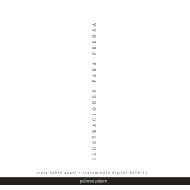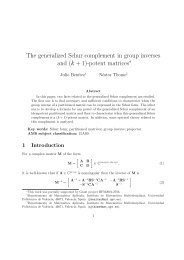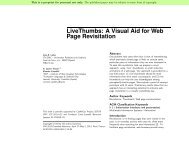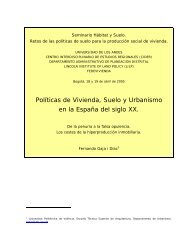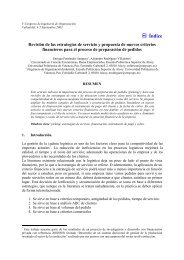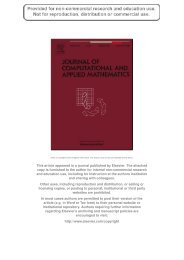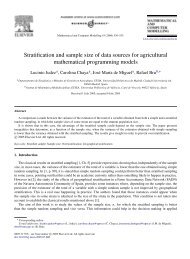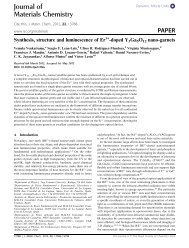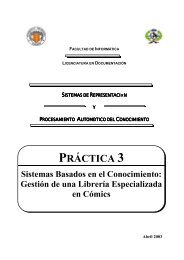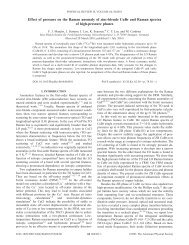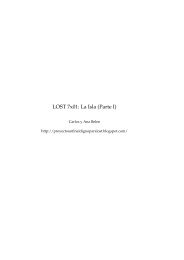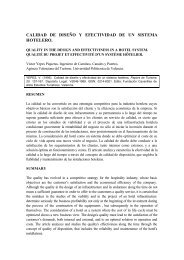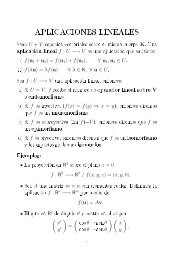Introduction to the resistivity surveying method. The resistivity of ...
Introduction to the resistivity surveying method. The resistivity of ...
Introduction to the resistivity surveying method. The resistivity of ...
You also want an ePaper? Increase the reach of your titles
YUMPU automatically turns print PDFs into web optimized ePapers that Google loves.
5<br />
2 2-D electrical imaging surveys<br />
2.1 <strong>Introduction</strong><br />
We have seen <strong>the</strong> greatest limitation <strong>of</strong> <strong>the</strong> <strong>resistivity</strong> sounding <strong>method</strong> is that it does<br />
not take in<strong>to</strong> account horizontal changes in <strong>the</strong> subsurface <strong>resistivity</strong>. A more accurate model<br />
<strong>of</strong> <strong>the</strong> subsurface is a two-dimensional (2-D) model where <strong>the</strong> <strong>resistivity</strong> changes in <strong>the</strong><br />
vertical direction, as well as in <strong>the</strong> horizontal direction along <strong>the</strong> survey line. In this case, it is<br />
assumed that <strong>resistivity</strong> does not change in <strong>the</strong> direction that is perpendicular <strong>to</strong> <strong>the</strong> survey<br />
line. In many situations, particularly for surveys over elongated geological bodies, this is a<br />
reasonable assumption. In <strong>the</strong>ory, a 3-D <strong>resistivity</strong> survey and interpretation model should be<br />
even more accurate. However, at <strong>the</strong> present time, 2-D surveys are <strong>the</strong> most practical<br />
economic compromise between obtaining very accurate results and keeping <strong>the</strong> survey costs<br />
down. Typical 1-D <strong>resistivity</strong> sounding surveys usually involve about 10 <strong>to</strong> 20 readings, while<br />
2-D imaging surveys involve about 100 <strong>to</strong> 1000 measurements. In comparison, 3-D surveys<br />
usually involve several thousand measurements.<br />
<strong>The</strong> cost <strong>of</strong> a typical 2-D survey could be several times <strong>the</strong> cost <strong>of</strong> a 1-D sounding<br />
survey, and is probably comparable with a seismic survey. In many geological situations, 2-D<br />
electrical imaging surveys can give useful results that are complementary <strong>to</strong> <strong>the</strong> information<br />
obtained by o<strong>the</strong>r geophysical <strong>method</strong>. For example, seismic <strong>method</strong>s can map undulating<br />
interfaces well, but will have difficulty (without using advanced data processing techniques)<br />
in mapping discrete bodies such as boulders, cavities and pollution plumes. Ground radar<br />
surveys can provide more detailed pictures but have very limited depth penetration in areas<br />
with conductive unconsolidated sediments, such as clayey soils. Two-dimensional electrical<br />
surveys should be used in conjunction with seismic or GPR surveys as <strong>the</strong>y provide<br />
complementary information about <strong>the</strong> subsurface.<br />
2.2 Field survey <strong>method</strong> - instrumentation and measurement procedure<br />
One <strong>of</strong> <strong>the</strong> new developments in recent years is <strong>the</strong> use <strong>of</strong> 2-D electrical<br />
imaging/<strong>to</strong>mography surveys <strong>to</strong> map areas with moderately complex geology (Griffiths and<br />
Barker 1993). Such surveys are usually carried out using a large number <strong>of</strong> electrodes, 25 or<br />
more, connected <strong>to</strong> a multi-core cable. A lap<strong>to</strong>p microcomputer <strong>to</strong>ge<strong>the</strong>r with an electronic<br />
switching unit is used <strong>to</strong> au<strong>to</strong>matically select <strong>the</strong> relevant four electrodes for each<br />
measurement (Figure 5). At present, field techniques and equipment <strong>to</strong> carry out 2-D<br />
<strong>resistivity</strong> surveys are fairly well developed. <strong>The</strong> necessary field equipment is commercially<br />
available from a number <strong>of</strong> international companies. <strong>The</strong>se systems typically costs from about<br />
US$15,000 upwards. Some institutions have even constructed “home-made” manually<br />
operated switching units at a nominal cost by using a seismic cable as <strong>the</strong> multi-core cable!<br />
Figure 5 shows <strong>the</strong> typical setup for a 2-D survey with a number <strong>of</strong> electrodes along a<br />
straight line attached <strong>to</strong> a multi-core cable. Normally a constant spacing between adjacent<br />
electrodes is used. <strong>The</strong> multi-core cable is attached <strong>to</strong> an electronic switching unit which is<br />
connected <strong>to</strong> a lap<strong>to</strong>p computer. <strong>The</strong> sequence <strong>of</strong> measurements <strong>to</strong> take, <strong>the</strong> type <strong>of</strong> array <strong>to</strong><br />
use and o<strong>the</strong>r survey parameters (such <strong>the</strong> current <strong>to</strong> use) is normally entered in<strong>to</strong> a text file<br />
which can be read by a computer program in a lap<strong>to</strong>p computer. Different <strong>resistivity</strong> meters<br />
use different formats for <strong>the</strong> control file, so you will need <strong>to</strong> refer <strong>to</strong> <strong>the</strong> manual for your<br />
system. After reading <strong>the</strong> control file, <strong>the</strong> computer program <strong>the</strong>n au<strong>to</strong>matically selects <strong>the</strong><br />
appropriate electrodes for each measurement. In a typical survey, most <strong>of</strong> <strong>the</strong> fieldwork is in<br />
laying out <strong>the</strong> cable and electrodes. After that, <strong>the</strong> measurements are taken au<strong>to</strong>matically and<br />
s<strong>to</strong>red in <strong>the</strong> computer. Most <strong>of</strong> <strong>the</strong> survey time is spent waiting for <strong>the</strong> <strong>resistivity</strong> meter <strong>to</strong><br />
Copyright (1999-2001) M.H.Loke



